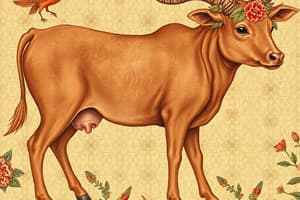Podcast
Questions and Answers
Which organisms can prepare their own food by photosynthesis?
Which organisms can prepare their own food by photosynthesis?
- Plants (correct)
- Bees
- Animals
- Snakes
How do bees and hummingbirds obtain their food?
How do bees and hummingbirds obtain their food?
- By filtering tiny food particles
- By eating mother's milk
- By sucking nectar from plants (correct)
- By swallowing animals
What do animals require food for?
What do animals require food for?
- Energy production
- Photosynthesis
- Nutrient absorption
- Growth, repair, and body functioning (correct)
How do snakes like pythons feed on their prey?
How do snakes like pythons feed on their prey?
What are the components of food that need to be broken down into simpler substances for utilization?
What are the components of food that need to be broken down into simpler substances for utilization?
Which animals filter tiny food particles floating nearby and feed upon them?
Which animals filter tiny food particles floating nearby and feed upon them?
What is the process by which starfish feed on animals covered by hard shells of calcium carbonate?
What is the process by which starfish feed on animals covered by hard shells of calcium carbonate?
Which part of the human digestive system secretes digestive juices to convert complex substances of food into simpler ones?
Which part of the human digestive system secretes digestive juices to convert complex substances of food into simpler ones?
What is the function of the buccal cavity in humans during digestion?
What is the function of the buccal cavity in humans during digestion?
What is the purpose of the large intestine in the human digestive system?
What is the purpose of the large intestine in the human digestive system?
What is the significance of milk teeth in humans?
What is the significance of milk teeth in humans?
How does the starfish digest its food after consuming it?
How does the starfish digest its food after consuming it?
Flashcards are hidden until you start studying
Study Notes
Nutrition in Plants and Animals
- Plants prepare their own food through photosynthesis, but animals cannot and obtain food from plants directly or indirectly.
- All organisms, including humans, require food for growth, repair, and body functioning.
Modes of Taking Food
- Different organisms have unique ways of taking food into their bodies.
- Examples include:
- Bees and humming-birds sucking nectar from plants
- Infants feeding on mother's milk
- Snakes swallowing their prey whole
- Aquatic animals filtering tiny food particles from the water
Components of Food
- Food consists of various components, including:
- Carbohydrates
- (Other components not specified)
Modes of Feeding in Different Animals
- Various modes of feeding exist, including:
- Scraping
- Chewing
- Siphoning
- Capturing
- Swallowing
- Sponging
- Sucking
- Examples of animals and their modes of feeding include:
- Snails: scraping
- Ants: unknown
- Eagles: capturing and swallowing
- Humming-birds: sucking
- Lice: unknown
- Mosquitoes: sucking
- Butterfly: sipping
- House fly: unknown
Digestion in Humans
- Food passes through a continuous canal (the alimentary canal or digestive tract) from the mouth to the anus.
- The canal is divided into compartments, including:
- Buccal cavity (mouth)
- Oesophagus (foodpipe)
- Stomach
- Small intestine
- Large intestine
- Rectum
- Anus
- Digestive juices from glands like salivary glands, liver, and pancreas break down complex food substances into simpler ones.
The Digestive System
- The digestive system consists of the digestive tract and associated glands.
- The system breaks down complex food substances into simpler ones through digestion.
- The mouth and buccal cavity are the first points of digestion, where food is taken in and broken down by saliva.
Teeth
- Humans have two sets of teeth: milk teeth and permanent teeth.
- Milk teeth grow during infancy and fall off between six to eight years old.
- Permanent teeth replace milk teeth and can last throughout life or fall off due to old age or dental disease.
Studying That Suits You
Use AI to generate personalized quizzes and flashcards to suit your learning preferences.




